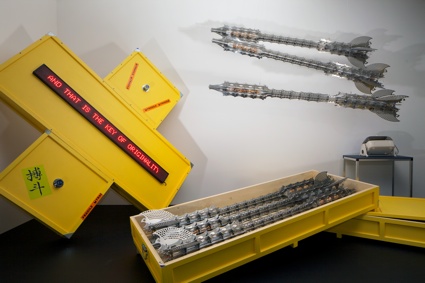 Supereste ut Pugnatis (Pugnatis) ut Supereste (SPPS), 2013. Photo credit Ian Hobbs
Supereste ut Pugnatis (Pugnatis) ut Supereste (SPPS), 2013. Photo credit Ian Hobbs
There was a time, not so long ago, when you could visit a new exhibition showing ‘bio tech artworks’ every second month. These days are over. At least in Europe. But it’s a different story in Australia where semipermeable (+) opened last month in the context of ISEA2013. semipermeable (+) looks at the membrane as a site, metaphor and platform for a series of artistic interventions and projects, some commissioned specifically for the exhibition and others selected from the many projects developed at SymbioticA (an artistic laboratory located within the School of Anatomy, Physiology and Human Biology, University of Western Australia) since 2000.
I haven’t seen the show so i’ll let Oron Catts, curator of the exhibition, present it in the interview he did with RealTime:
realtime tv @ ISEA2013: semipermeable (+), SymbioticA
Some of the works in the show have been developed by artists while they were in residence at SymbioticA in the past. Others were especially commissioned for semipermeable (+). This is the case for Supereste ut Pugnatis (Pugnatis) ut Supereste, or SPPS, by sculptor and sound artist Dr Nigel Helyer.
Helyer’s work is rich and manifold. Behind its alarming aspect, SPPS considers selectively permeable structures under lenses that range from the molecular level to the macro scale.It explores the (xenophobic) history of immigration in Australia and more generally current infrastructures that define socio-political boundaries. It also looks at the history of biowarfare, from Antique Chinese gunpowder rockets carrying poisonous material to virus injected into chicken eggs.
There was much to talk about and ask Nigel Helyer. hence the email exchange i’m copy/pasting below:
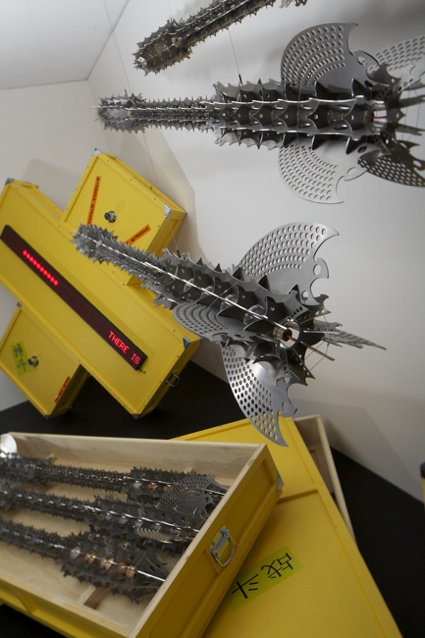 Supereste ut Pugnatis (Pugnatis) ut Supereste (SPPS), 2013. Photo credit Ian Hobbs
Supereste ut Pugnatis (Pugnatis) ut Supereste (SPPS), 2013. Photo credit Ian Hobbs
What makes your work particularly attractive is the menacing steel weapons. They look like missiles. What inspired their shape exactly?
Two things, firstly the long tradition of Chinese gunpowder rocketry which is documented from the C10th. These were used for both festive and military purposes and there are accounts of “bio-hazardous” material being included in the payload (for example excrement or putrefying remains). The second strand is primarily morphological – the profile of the rockets is based upon an elongated “Bacteriophage” a virus that locks onto bacteria, injects its DNA and in effect turns the bacterium into a virus replicating factory. This resonates with the concept of genetic and/or ethnic mixing within national borders.
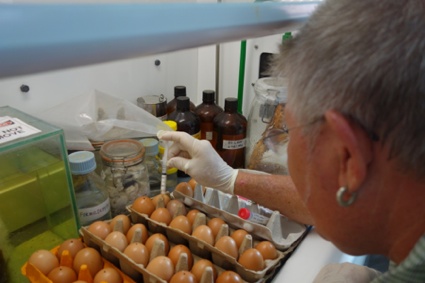 Nigel infecting eggs
Nigel infecting eggs
One of the phase in the development of the project involved infecting eggs. Can you take us through this process? What did you use to infect them? Is it the ‘omnisexual bacterium’ your text mentions?
As the work is designed for public museum display the work had to be relatively innocuous. Thus I used chicken eggs which I first ‘blew’ I.e. emptied them if their contents, and then lacquered and sealed at one end. Next the eggs were injected with a small amount of a lab strain of E.Coli bacteria (common in the human intestines) suspended in a polymer. These were left to dry out in a lab facility and samples tested for viability. Once the samples showed no further growth possibility the eggs were sealed and then double contained in scientific glass (making them safe for the Museum context). The omni sexual bacterium in the text actually refers to the structure of Metaphor. In essence the idea that in the work several apparently desperate strands if thought, history and biology are bought together to ‘mingle’ – I parallel this to the omni sexuality of bacteria which can exchange genetic material quite freely, mixing and matching, as with ideas as with metaphor.
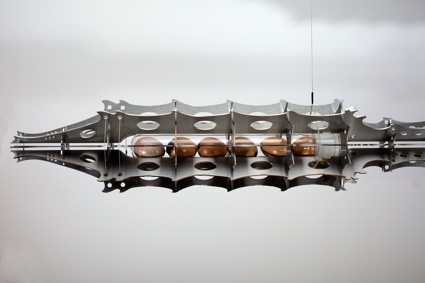 Supereste ut Pugnatis (Pugnatis) ut Supereste (SPPS), 2013. Photo credit Ian Hobbs
Supereste ut Pugnatis (Pugnatis) ut Supereste (SPPS), 2013. Photo credit Ian Hobbs
The work, you write, pays an “ironic homage that reprises the origins of modern bio-warfare research, where chicken eggs were the bio-reactor of choice at the Chemical Defense Establishment of Porton Down near Salisbury UK.” I’ve never heard about the role of eggs in biodefense. Could you tell us more about it?
Well rather simple really. eggs are obviously natural incubators and were chosen as the original bio- reactors in most Chemical and Biological Warfare labs prior to the development of artificial (and therefore more standardized bio- reactors.) Eggs components are still used in the production of many serums and inoculations for regular medical use.
What makes your work ‘semipermeable’? What gets in and what is left outside?
This relates more to the socio-political reading of the word, the border, the frontier, the policing of who may pass and who is turned away.
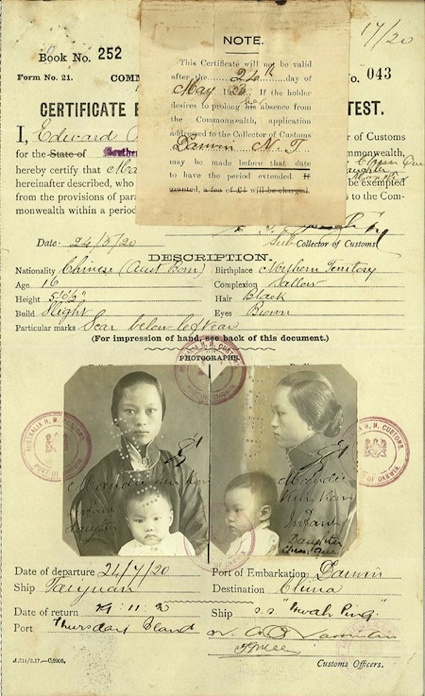 Dictation test exemption certificate
Dictation test exemption certificate
There is also a sound component to the work, if i understood correctly. Can you explain it to us? What it is and which role it plays in the whole work.
This relates to the above, the national border, and the “Dictation Test” as applied to Asian immigrants to Australia between 1901 and 1958 under the “White Australia” policy. Asian migrants were made to take a 50 word dictation as a test of English skills. In reality many English speakers would fail and the system was a thin disguise for a racist policy for refusing entry to anyone other than Caucasians.
The scrolling text on the LED board contains just three of the hundreds of examples (to be found in the National archives) and the audio component is a Chinese translation of these three texts.
Ultimately, your work looks pretty dangerous. How do you get to exhibit a work that looks like a weapon and contains infected eggs? Are there special rules to comply to show the work in an art exhibition?
Again simple common sense from the museum team, I ensured that the bio hazard was reduced to less than a Big Mac Burger (actually a sample from a MacDonalds Cafe table could well be more harmful) and then the museum was okay with just a simple discreet wire barrier – so far no fatalities!
Thanks Nigel!
Semipermeable (+) semipermeable (+) at the Powerhouse Museum in Sydney until 21 August 2013.
Also part of the exhibition: In-Potentia, from foreskin cells to ‘biological brain’.
